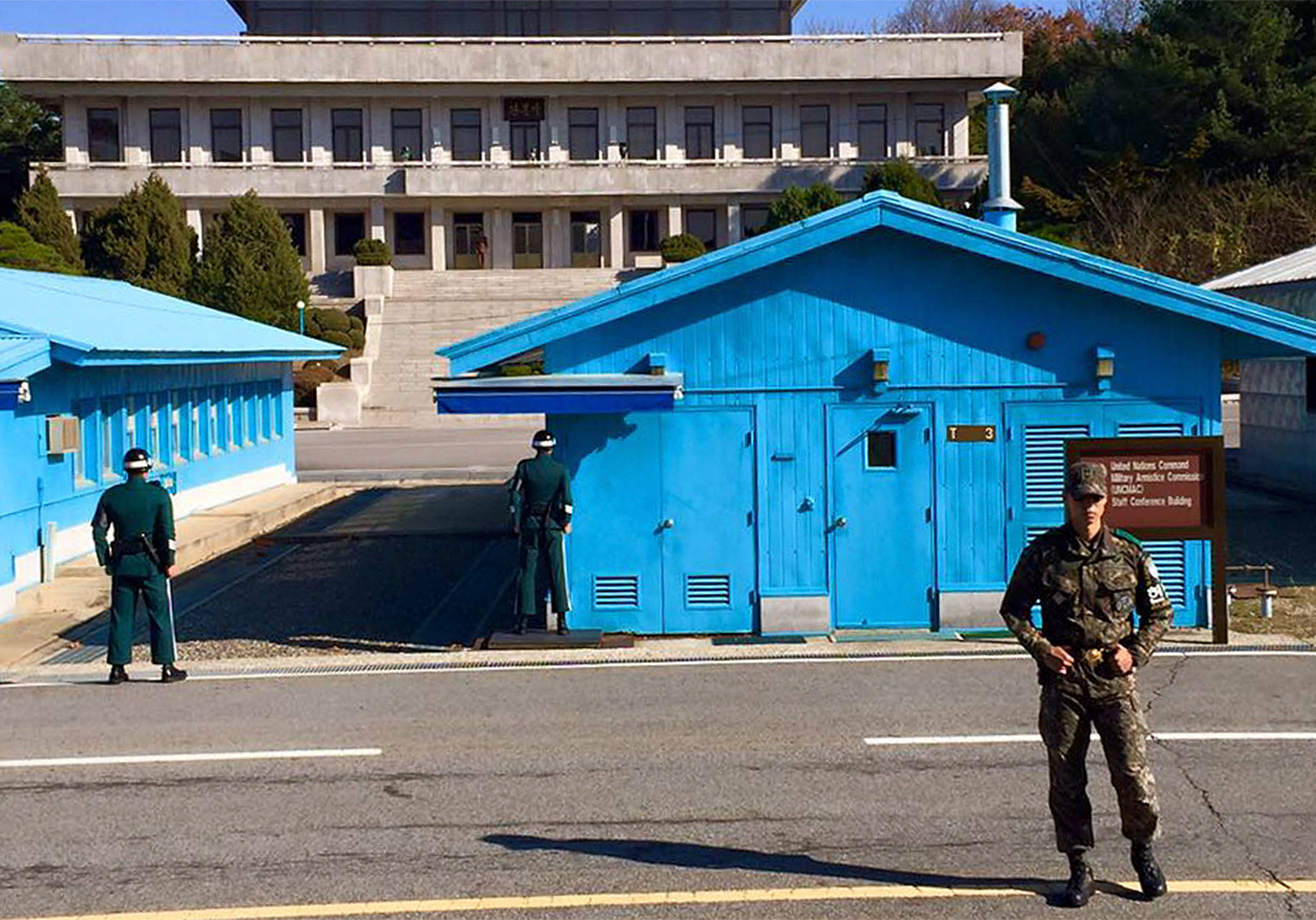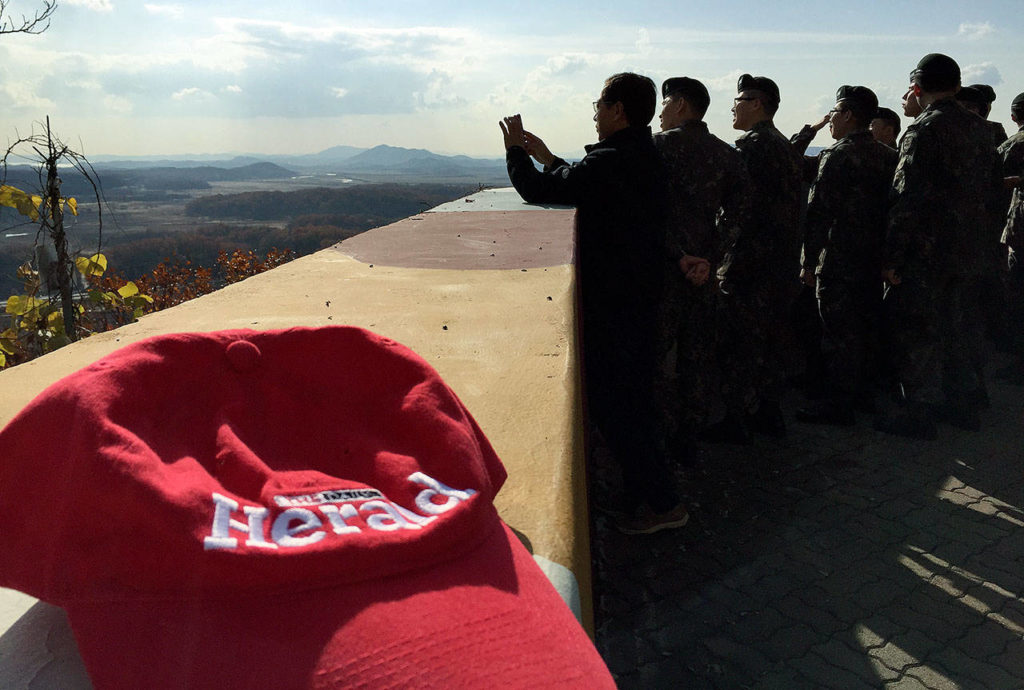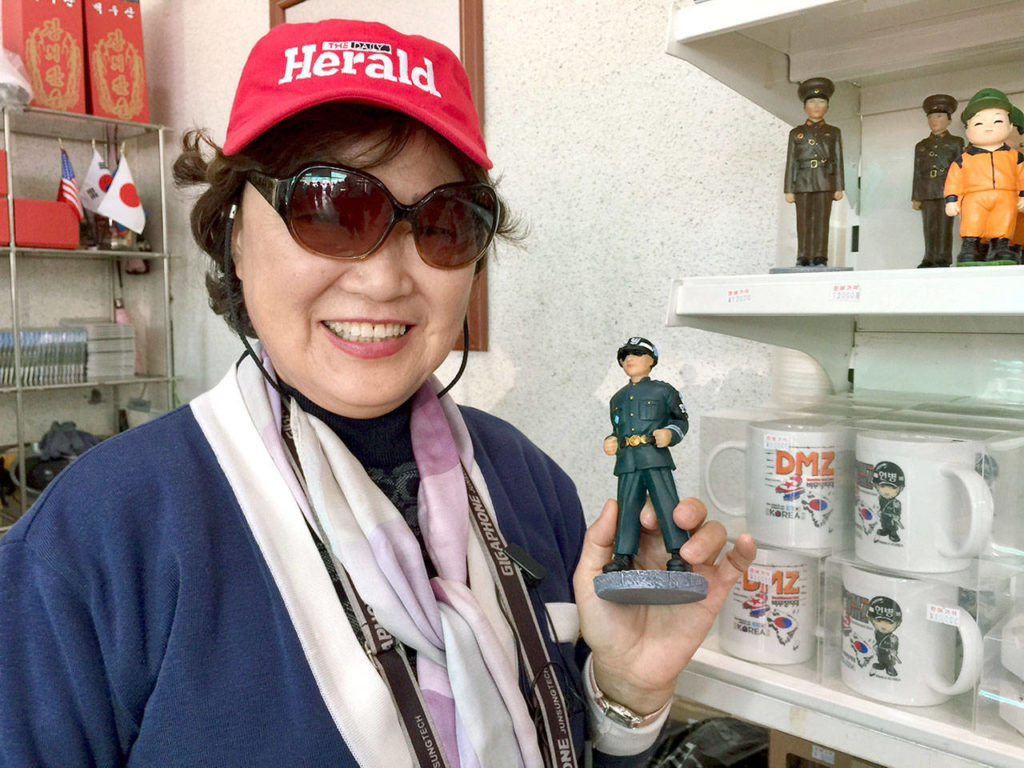I stood on the border of South and North Korea. A bunch of heavily armed guys from opposing sides stood inches away, their faces dour and unblinking.
I wasn’t afraid.
I’d even signed a waiver about the “possibility of injury or death as a direct result of enemy action” on my tour of the Demilitarized Zone.
That was two years ago.
Now, as I watch the North Korea missile mania from my cozy Mukilteo living room, I am scared.
It’s 5,000 miles away, but I know it could, literally, hit home. Or a nuclear weapon fired on Kim Jong Un’s whim could kill millions of people elsewhere.
Or that the U.S. will nuke North Korea with catastrophic results.
Or all of the above.
In the zone
In November 2015, I was among a group of seven American journalists on a 10-day fellowship sponsored by the East-West Center in Hawaii and the Korea Press Foundation. We traveled to four cities in South Korea, meeting with lawmakers, filmmakers, professors and news producers. At my request, we even went to a Costco.
From the ancient dynasty village Gyeongju to the white sandy beaches of Jeju to Seoul’s neon-lit streets, what I saw was a vibrant and progressive country — until we went to the Demilitarized Zone.
There, a mere 35 miles north of Seoul, the landscape turned drab and ominous.
The term “demilitarized” is a misnomer. The 2.5-mile-wide buffer zone between the countries is heavily fortified with military.
Guard houses. Electric fences. Barren fields. A gray skyline, beyond which I could easily envision thousands of soldiers goose stepping in parade formation, their legs swinging off the ground in unison.
A glimpse of the DMZ is one reason I applied for the fellowship. It’s an enduring Cold War symbol of misery and mystique. The Korean Peninsula was divided after World War II, and the communist North became a dictatorship now run by 33-year-old Kim Jong Un, who loves the NBA yet hates the USA.
The country is divided. Families are fractured. Only tension is shared.
Postcards, T-shirts
The DMZ is a popular tourist attraction for foreigners. The guide on our tour bus from Seoul to the DMZ was a cheerful South Korean woman in her 50s.
“I don’t know what’s going to happen today,” she told us after we were too far down the road to change our minds. “They have guns, but I’m still alive.”
She seemed way too happy to be leading tours to this depressing zone.
It got better a few checkpoints later. When we pulled into the lot packed with other tour buses, it seemed more theme-parkesque, but in an eerie way.
That’s where we signed the waiver stating we were knowingly entering hostile territory and might not live to tell about it.
Like Disneyland, at DMZ-land they took our photo on the way in and tried to sell it to us for $20 on the way out. It came with a glossy keepsake booklet with the highlights of the tour.
One stop was an observatory with a panoramic view of the bleak North Korean landscape and mounted binoculars for a better look of the fake city known as “Propaganda Village.”
Another stop was a mile-long tunnel, 240 feet down, that was being secretly built by the North when discovered in 1978. Now it’s a thrill ride, of sorts, with a tram then a walk through the tunnel devised to move 30,000 North troops an hour to attack the South.
The slickest part was the Joint Security Area, where the North and South Korean forces stand stone-faced to stone-faced. Inside one of those rectangular blue buildings (like you see on TV), tourists can take a step over the North Korean border and say they’ve been there. Our group was instructed to gather around the table on the North side for a photo, which was included in the glossy booklet that, of course, we purchased.
And, yes, there were souvenir shops.
We later joked about it being the “de-money-ized zone” after we bought DMZ postcards, T-shirts, mugs and refrigerator magnets.
That wasn’t to trivialize the reasons why this strange tourist attraction was there. It was sad, thinking about the families separated by this Cold War, and the hardships the trapped people of the North endure in the isolated, impoverished hermit kingdom.
Tense times
Torturing their own people isn’t enough for the Kim Jong Un clan, which also threatens to blow up countries they don’t like.
My daughter-in-law, Ayako, grew up in Japan, where the perennial threat of missile strikes from North Korea has been going on for years.
“It’s the same as earthquakes. You never know when it will happen,” she said.
Her parents, who live in Kyoto, called her a few days ago, worried about the possibilities of missiles striking Seattle.
“You’re closer than we are,” Ayako told them. Her mom said, “They want to beat America more than Japan.”
I wondered if people in South Korea are scared. After all, they are the most convenient target for practice tests of missiles and chemical weapons. Stories online show people on picnics, dancing to K-pop and grabbing a late-night bite at street food stalls.
I contacted journalist Haejoo Kang, program manager at the Korea Press Foundation, to pick her brain. She escorted us on our trip and is based in downtown Seoul.
“It is almost the same as usual,” Kang replied in an email. “The stock market is so volatile, but there’s no hoarding products or panic buying. It’s summer holiday season, so people are enjoying their vacation as usual. … It doesn’t seem life-threatening.”
There is some anxiety, but it stems more from the leader of the U.S. than the guy ordering the missile launches in North Korea.
President Donald Trump vowed to unleash “fire and fury” against North Korea. Kim Jong Un counter-punched with a threat to blast Guam. Continuing the war of words, Trump said the U.S. was “locked and loaded.”
“When I heard ‘fire and fury’ from Trump, it reminded me of Bush’s designation of ‘axis of evil’ in the past,” Kang said. “One of my colleagues, Sang-gi Lee, said, ‘I think Koreans are more afraid of Trump than Kim Jong Un.’ And others agreed. People don’t trust Trump. One called him ‘freak madman.’… He’s notorious for his handshake and rough words and Twitter politics.”
The Korean government assigned an officer to exclusively monitor Trump’s tweets.
Kang said DMZ tours have been affected because the number of Chinese tourists has been declining due to the relations between Korea and China.
“Not only because of Chinese tourists’ decrease, but also because of Western tourists’ decline, some of the tours are canceled,” she said.
Want to go?
Expedia offers the DMZ tour for $50. A plane ticket to Seoul is not included.
Worth the trip
South Korea is a place I likely would have never gone if not for the journalism fellowship. I didn’t know much about the country, other than the DMZ, which hogs the media attention.
I was impressed by the stunning beauty of South Korea. The streets were clean. Mass transit ran like a clock. Meals were delicious. People were respectful and proud. The homeless slept in tidy cardboard boxes, their clothes neatly folded.
Several times I asked: Why would anybody want to leave here to move to America? It came down to two words: Better opportunities.
What I didn’t see were the problems common to post-industrial societies, such as a gap between the rich and the poor, conflicts between generations, pollution and social pressure to be perfect.
I want to go back to South Korea. I hope that when I do, the DMZ will have become a symbol of the division that once was, and that eerie theme park is an actual park where people from any latitude can cross with ease and gather without fear.
Andrea Brown: 425-339-3443; abrown@heraldnet.com. Twitter: @reporterbrown.
About the trip
The East-West Center, headquartered in Hawaii, was established by the U.S. Congress in 1960 to promote better relations and understanding among the people of the United States, Asia and the Pacific through cooperative study, research and dialogue. The center sponsors journalism fellowships between the U.S. and Korea, Pakistan, Japan and China.
Herald features reporter Andrea Brown was on the 2015 U.S.-Korea study tour with American journalists from CNN, Huffington Post, NPR, Al Jazeera and The Plain Dealer. The group traveled around the country by bus, plane and train to Jeju Island, Busan, Gyeongju, Seoul and the DMZ. They took a taxi to Costco.
The Korea Press Foundation is a nonprofit and nonpartisan organization dedicated to promoting professional journalism in Korean media.
Since her trip to South Korea, Brown has been looking for people in Snohomish County who would be interested in sharing stories on issues such as Korean adoptions and culture.
Talk to us
> Give us your news tips.
> Send us a letter to the editor.
> More Herald contact information.




























